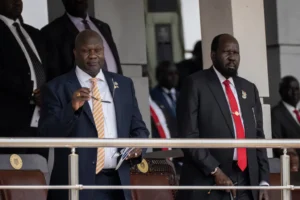Esan Traditional Marriage
The Women Leader Say: Ishan Oyee
All Women’s Response: Oyeee
This is a typical call and response at any Esan traditional wedding ceremony. Esan is an ethnic group from the southern part of Niger
The Esan tribe is rich with beautiful and diverse cultural heritage. One of the most cherished aspects is their traditional marriage rite. They devote considerable attention and dedication to every detail.
The Esan pay careful consideration and attention to the union of marriage. They believe in the beauty and purity of marriage, love, family, and legacy as the true essence and beginning of societal life and living. When marriage is gotten right, it births a peaceful, progressive, and healthy society, which is the bedrock of national growth and progress. Family is the foundation of a community, and marriage is the journey.
The Esan place great importance on their traditional marriage. As such, there are some key norms and customs that are core values governing marriage. For example:
Issues of adultery and assault by either party have consequences.
Proper education and investigation are carried out on both parties to ensure readiness and to uphold the purity of marriage.
Marriage in Esan culture is not just a union of two individuals but also the coming together of two families.
There is a session of the wedding ceremony where the elders ask two major questions:
Consent from the groom’s family: They verify if the family gave their consent willingly and not under coercion. Both families must respond in agreement.
The bride price presentation: The bride’s family collects the smallest amount and returns the bulk of it to the groom with these specific words:
“OUR CHILD IS NOT FOR SALE, WE DIDN’T TRADE HER, SO SHE MUST BE TAKEN CARE OF AND LOVED WITHOUT MALTREATMENT.”
These, amongst others, are the highlights of the conversations in the inner room of the wedding ceremony by the elders and families.
Two Major Steps in Esan Traditional Marriage
First Step: Isheee (The Visit)
The first formal process is called Isheee, meaning to visit.
The groom, with a few family members, visits the bride’s family with small tokens of respect such as:
Drinks
Kola nuts
Gifts
This visit introduces the groom and his intentions. Once terms are agreed upon and information shared, a date for the proper wedding is fixed.
During this period:
The bride’s parents conduct discreet background checks (family history, health, character, and morals).
Courtship and visitation foster familiarity and trust between both families.
The groom receives the bridal list (items required for the marriage).
People to be invited with tokens:
Elders/Kinsmen – a bottle of hot drink & kola nuts.
Senior women/community women – a pack of drinks & kola nuts.
Immediate family – nuclear & extended (no gifts required).
Standard bridal list items include:
Kolanut
Hot drink/Gin
Palm wine
Red oil
21 tubers of yams
Honey
Bride price cash (N24 or N25 naira, though some families collect no more than N200)
Other items
These items are shared between male elders and women, symbolizing that as parents ate of their child, she too will eat of her own children.
Important cultural note: When an Esan wife dies, her body must be returned to her father’s homeland (otoesan), unless otherwise permitted by rites. This shows honor to the Esan woman.
Second Step: The Wedding Day
This is the actual marriage ceremony.
Bride’s Appearance:
Hairstyle: Okuku – crown-like style with coral beads, symbolizing royalty, wealth, and heritage.
Attire: Red velvet with beads or George wrapper.
Groom’s Appearance:
Attire: Igbulu or Egbu – George wrapper with a whip in hand.
Ceremony Highlights:
Held at the bride’s home.
Inner chamber: Groom presents bridal list items; families finalize marriage rites.
If the bride is already pregnant, the dowry (cash) is withheld until after childbirth (symbolized by: “One does not sell a goat with a child”).
Fun Tradition: The bride comes out veiled with other similarly dressed girls. The groom must identify his bride. Before this, the bride’s women jokingly demand money, saying a fallen tree blocked her way and they need money for a tractor.
Final Blessing:
Bride is carried by her father and placed on the groom’s lap 7 times.
On the last count, the groom must hold her firmly.
Families pray and bless the union.
After Ceremony:
The mother of the bride gifts her with kitchen equipment.
Songs, praises, and gifts follow.
The bride does not leave immediately with the groom. Instead, her family escorts her in the evening to her husband’s home, sometimes continuing the celebration there.
Conclusion
Esan traditional marriage is beyond meeting cultural rites. It is about finding a family, building a new home, and creating love and unity that strengthen society.










